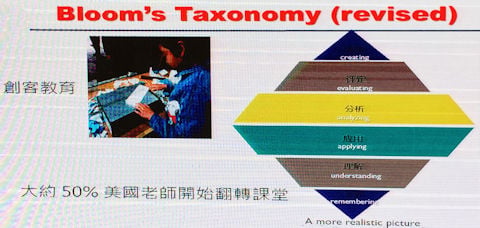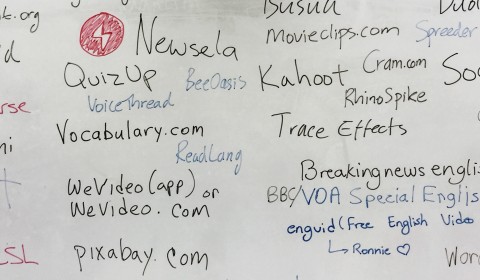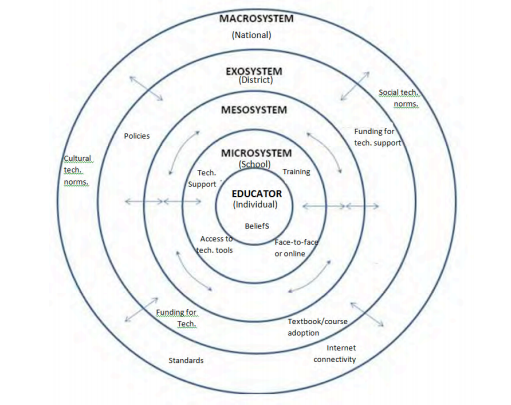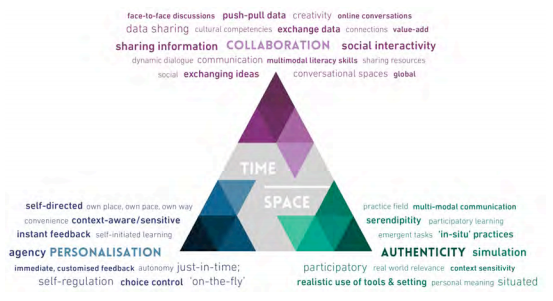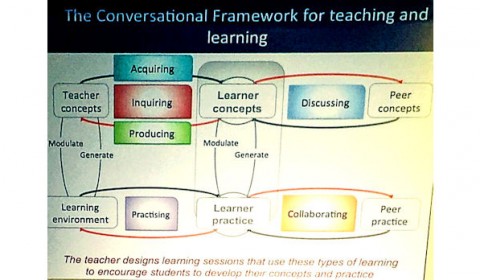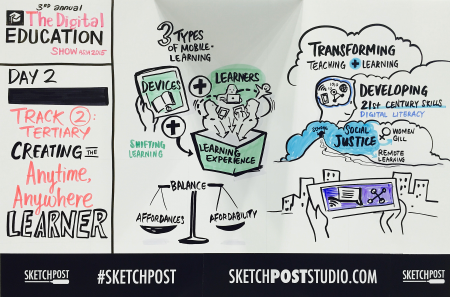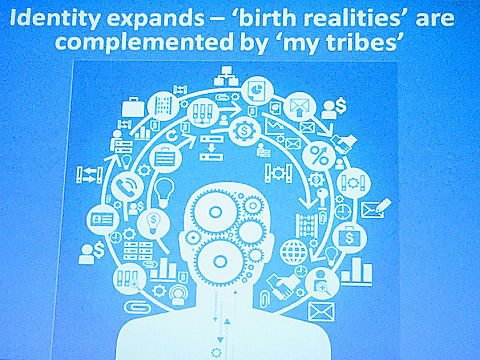IAFOR ACLL/ACTC Conference
Kobe, Japan
11-14 May, 2017
The annual conferences, The Asian Conference on Language Learning and The Asian Conference on Technology in the Classroom, came together over several days in an IAFOR-organised event in Kobe in the midst of Japanese springtime this year. Along with keynotes that gave broad overviews of the conference theme of ‘Educating for Change’, there were numerous papers presenting different aspects of teaching and learning with digital technologies.
In his opening keynote, Change in Japanese tertiary education: Implementing content and language integrated learning (CLIL) in Japan, Ted O’Neill spoke of how the European concept of CLIL is beginning to make inroads into Japan, with content being taught through the target language, and the target language simultaneously being investigated through the content. In CLIL, there should be constant feedback, he suggested, between content and language. It is possible to have both soft and hard versions of CLIL, with educators at either end of this spectrum potentially being able to meet, over time, in the middle. Offering CLIL, he went on to say, helps prepare for globalisation; helps students access international certifications; and sends a strong message about plurilingual education. In preparing students for future studies, he mentioned, it is possible to offer modules focusing on ICTs incorporating international lexis.
In my own keynote, Beyond web 2.0: Designing authentic mobile learning for everyday contexts in Asia, I suggested that we need to move beyond web 2.0, while retaining the best of its elements of personalisation and collaboration in learning, but using mobile devices and especially mobile augmented reality to add in greater elements of authenticity, situatedness and contextualisation. I showcased mobile AR learning trails from Singapore, Indonesia and Hong Kong to demonstrate how educators are already establishing successful precedents in this area.
In her keynote, Instructional designers as agents for change: Facilitating the next generation of technology-enhanced learning, Barbara Lockee outlined the ADDIE Learning Design Model, involving stages of analysis, design, development, implementation and evaluation. The wider setting is now changing, she argued, leading to the need for instructional designers to address the advent of learning sciences, the rise of flexible opportunities through for-profit institutions, the emergence of a culture of innovation in universities, and the renewed interest in personalised learning opportunities. She went on to say that the field of instructional design and technology originated in the convergence of media and technology, and suggested that designers can leverage what is known about human learning in the systematic design of instructional solutions. Ultimately, instructional designers can function as change agents across a range of disciplines. Importantly, she also noted that technology doesn’t always have to be part of the solutions that instructional designers propose.
She finished by suggesting that the next generation of technology-enhanced learning can be sparked through collaborative, creative thinking about how to leverage the affordances of technological innovations and overcome barriers to the adoption of innovation for the advancement of learning – something that is possible at conferences like this one.
Among the many presentations on the use of digital technologies in education, the tools and techniques considered ranged from educational apps and platforms, digital storytelling and gaming through the flipped approach to mobile learning, including mobile augmented reality (AR) and robots.
In her presentation, An investigation of the integration of synchronous online tools into task-based language teaching: The example of SpeakApps, Nouf Aljohani reported on an initiative where female Saudi students, who normally have insufficient opportunities to practise spoken English outside the classroom, were asked to use SpeakApps to increase their amount of practice. The video chat function allowed up to six students at a time to engage in an online chat, with the recorded conversation being uploaded to a blog where it could be revisited to identify strengths and weaknesses. Students met online for an hour a week outside of class. Each speaking task had a communicative purpose, involved students in authentic tasks to develop critical thinking skills, and related to the Saudi context.
In their presentation, A case study of using Edmodo to enhance language learning for Japanese and British students at tertiary level, Shinji Okumura and Miho Inaba suggested that the term CALL is somewhat outdated, with TELL (Technology Enhanced Language Learning) and MALL (Mobile Assisted Language Learning) being more contemporary expressions. He described the Edmodo platform, indicating its similarities to Facebook. He went on to report on a project where Japanese and British students conversed on Edmodo, using a mixture of Japanese and English language. The Japanese students felt that they had improved their English skills, including in areas such as organising texts in English and learning native English expressions; the British students also felt that they had gained valuable Japanese language practice and learned more about Japanese society. Most Japanese students used their smartphones to participate, and did so in moments of downtime, such as when waiting for trains. However, more frequent opportunities for interaction would have been preferable, and the groups were a little too large to permit close interaction. For the British students, who were at a lower level in Japanese, it was very time-consuming to type posts and read replies, and they needed teachers’ help to complete the tasks.
Turning to the use of technology in an underdeveloped context in their presentation, Shifting the paradigm in higher education: Students’ progression towards ICT-supported learning in a resource-constrained context, Peshal Khanal, Prem Narayan Aryal and Ellen Carm outlined a blended learning project for continuous professional development of teachers in Nepal. Within the project, Moodle was used as a platform along with Classjump (though the latter is no longer available), and teachers were encouraged to interact on Facebook as well. Aside from access and opportunities, students’ progression towards the use of ICTs was found to depend on factors such as perceived benefits, prior knowledge, learning difficulty, and the role of change agents (teachers) in motivating them. Over time, many students came to appreciate the learning potential of the internet. Issues included: access and reliability of technology, the dominance of traditional pedagogy, and teacher favoritism of bright students over others. Gender issues also surfaced: girls were reluctant to take the lead voluntarily in group work, and there was a feeling of insecurity around girls working and learning in what was generally understood as an unusual time and environment.
In her talk, Digital storytelling as assessment for learning in mathematics education, Sylvia Taube spoke about addressing early childhood pre-service teachers’ fears of mathematics through digital storytelling. Drawing on the work of Helen Barrett, she suggested that digital storytelling facilitates the convergence of four student-centred learning strategies:
- Student engagement
- Reflection for deep learning
- Project-based learning
- Effective integration of technology in instruction
Drawing on the work of Robin (2006), she went on to say that there are seven key elements of digital storytelling. These help students to convey their messages and their associated emotions effectively:
- Point of view
- A dramatic question
- Emotional content
- The gift of voice
- The power of the soundtrack
- Economy
- Pacing
Digital stories may be personal narratives; may examine historical events; and may inform or instruct.
She explained that she formerly asked her pre-service teachers to write about their own experiences of learning maths at school, but now she asks them to create multimedia digital stories. She showed an example of a story which was created in PowerPoint overlaid with other tools like Snapchat, including extensive use of AR effects to emphasise emotions in the video narration. Other students used Prezi, Animoto, PowToon, VoiceThread or Adobe Spark. Reflecting on past negative maths learning experiences helped many of them to realise what they need to do to help their own students in the future. She suggested that these digital storytelling skills will be very useful for these future teachers who can use the technology to help explain mathematics concepts to their students.
In her presentation, Digital games for English language learning: Students’ experiences, attitudes and recommendations, Louise Ohashi referred to the work of James Gee (2005), mentioning key learning principles of good games:
- identity
- interaction
- production
- risk-taking
- customisation
- agency
- well-ordered problems
- challenge and consolidation
- just-in-time or on demand
- situated meanings
- pleasantly frustrating
- system thinking
- explore, think laterally, rethink goals
- smart tools and distributed knowledge
- cross-functional teams
- performance before competence
She went on to report on a research project where she asked Japanese learners of English (n=102) about their experiences with digital games in English, and their attitudes towards games as a learning tool. Smartphones were the devices most commonly used by students to play games in English; in the previous 12 months, 31% had played an English game in class, and 50% out of class. There was a mixture of commercial games (Call of Duty, Battlefield, Grand Auto Theft, etc) and educational games (TOEIC Galaxy, Quizlet, Kahoot, etc). The majority of students thought it was valuable to play digital games in study time. Their comments suggested that they found games motivating and that in many cases they helped them to improve their English.
In her presentation, Flipping the classroom: Voices of teachers, Anna Ma reported on her research on the flipped approach in Hong Kong. She indicated that many teachers are already flipping their classes, though they may not be using video, and they may not be calling what they do a flipped approach. The flipped approach is in fact nothing new, though it may be becoming more popular. She outlined five key misconceptions about the flipped approach among teachers, as found in her research:
- Video is a must (though it can be very effective, it’s not a requirement)
- I have not done any flipping (teachers don’t realise they may already be doing this but without using video)
- It’s very time-consuming because I have to redo everything
- To flip or not to flip: there are no other options (it is possible to partly flip a class)
- I am not a techie; I don’t know anything about video or creating a video
Challenges include motivating students to watch the videos or do the other preparation before class; the sense of competition among teachers to create flipped classes; parents who think a flipped approach is akin to a kind of home schooling; a lack of technological resources for teachers; and the time demands on busy teachers.
The key point about the flipped approach, she concluded, referring to the work of Bergmann and Sams, is not about the videos, but about what can be done with the additional time in class.
In a different take on the flipped approach focused at primary level in the Philippines, The flipped classroom: Teaching the basic science process skills to high-performing 2nd grade students of Miriam College Lower School, Mark Camiling outlined some advantages of using a flipped approach: asynchronous quality; having class at home and doing homework in school; and more time for the teacher to detect students’ difficulties and needs. Challenges include internet connectivity; resource quality; student resistance; and deciding on curation versus creation of flipped content. Although some people might consider that primary students are not responsible enough or digitally literate enough, he found in his research that a flipped approach can be effective at primary level. It may also help to prepare younger students for future use of ICTs in school. It seems, however, that the flipped approach may work better for high-achieving than low-achieving students.
In their paper, Maximising the tablet learning experience: A study of MCHS Mathematics 7 teacher awareness and readiness in using tablet-based pedagogy, Lyle Espinosa, Mon Ritche Bacero and Lady Angela Rocena reported on a study of teachers’ attitudes to tablet use. It was found that teachers mainly used tablets as e-book readers in the classroom, and they used them in their lesson preparation to search for supplementary online resources and apps. Nevertheless, teachers agreed unanimously that tablets helped them explore new teaching techniques, and that they promoted student collaboration. The teachers viewed themselves as ‘engineers of lessons’ with the tablet as their tool. At the same time, teachers always prepared backups in case of technological problems. They were concerned that students were more knowledgeable than they were, and that there was an expectation that teachers should learn about new technologies without formal training.
In their paper, Using and developing educational applications for mobile devices as a tool for learning, Andrey Koptelov and James Hynes reported on a survey of teachers around Houston, USA, where they discovered that the three most commonly used educational apps were Kahoot, Plickers and Nearpod. While these are not pedagogically sophisticated, they can be engaging for students. The authors went on to suggest that students can be asked to create their own mobile apps, and that it is useful for pre-service teachers to have this design skillset. Their students created Android apps with MIT’s open source App Inventor, an example of a cloud-based IDE (Integrated Development Environment), which provides all the tools needed to develop a programme, in this case a mobile app. Other IDEs that can be used by students with no previous programming experience include Ionic Creator (iOS and Android) and Apple Swift Playground (iOS only).
When the pre-service teachers were asked to design an app, they had to fill in a spreadsheet covering the following details:
- Name of app/cost
- Platform/need for internet connection
- Detailed description of app
- Subject/grade level where app could be used
- Main use of app in the classroom (instruction, assessment, collaboration, etc)
- Which students will benefit most (ESL, special education, gifted and talented, etc)
- Blooms Taxonomy level or Vygotsky’s ZPD that could be targeted with app
- Benefits of app for teacher/school or parents/community
- Other comments
Only after undertaking this exercise were students asked to begin work with App Inventor to build the app itself. They got help from group members and guidance from the instructor. The next step then involved testing, feedback and reflection.
In their presentation, Augmented reality design principles for informal learning, Eric Hawkinson, Parisa Mehran, Mehrasa Alizadeh and Erin Noxon showcased a variety of case studies of AR, demonstrating how it can lead to real world connections and learner customisation. In one case, they showed the engagement of participants at TEDxKyoto. In another, they showed how students undertook an orientation activity to familiarise themselves with the university library, which involved students scanning AR markers placed around the library as they participated in an imaginary story where they had to search for clues to hunt a thief. Using the AR cards produced by the research team, students can also set up links to digital content they have created. Examples of these and other uses of AR can be seen in Eric Hawkinson’s ARientation Project YouTube channel.
In his presentation, Social robots as peer tutors for pre-travel study abroad preparation, Paul Wallace explained that when students are preparing to go abroad on study placements, they need greater familiarity with everyday norms of language use.
Social robotics focuses on developing machines capable of interacting with humans to assist and achieve progress in convalescence, rehabilitation, training and education. Robots are designed to be engaging but not threatening; embodiment in human form is engaging, and the non-threatening design aids belief that the robot is non-judgemental. The NAO V5 Robot “Max” has speakers, microphones, eyelids, cameras, sonars, prehensile hands with sensors, and a wifi connection to retrieve information from the web. It can have 19 different languages installed. It is programmable (using a software package called Choreographe) and is semi-autonomous, and it is possible to create scenarios and levels for its interactions.
The robot can be programmed as a language and cultural tutor for students who are going abroad. Programmes can be launched by showing the robot a NAO mark, which functions something like a QR code; it can then switch into a pre-programmed scenario. Levels can be set so that the robot recognises a range of pronunciations, or so that pronunciation must be very precise – this can be adjusted depending on the levels of the language learners. The robot is not meant to replace a human tutor, but it does offer advantages in terms of:
- availability (e.g., languages not available locally)
- access (24/7)
- flexibility (it never gets tired or offended)
- customisation
- adaptability (threshholds, speaking speeds)
- personalisation
- feedback (visual or audio feedback, recording and repeating students’ responses)
- interactive help
- student anxiety (non-threatening design to counteract foreign language anxiety)
All in all, we spent several days in rich discussions about the theme of educating for change. On the technological side, a key overarching theme was that different technology types and levels are appropriate for different teachers and students in different contexts, but that bringing together a range of researchers and practitioners from varying backgrounds facilitates the emergence of new ideas and insights in intercultural, interdisciplinary conversations.







